5 Most Effective Float Fishing Leader Setups Used By Pro River Guides
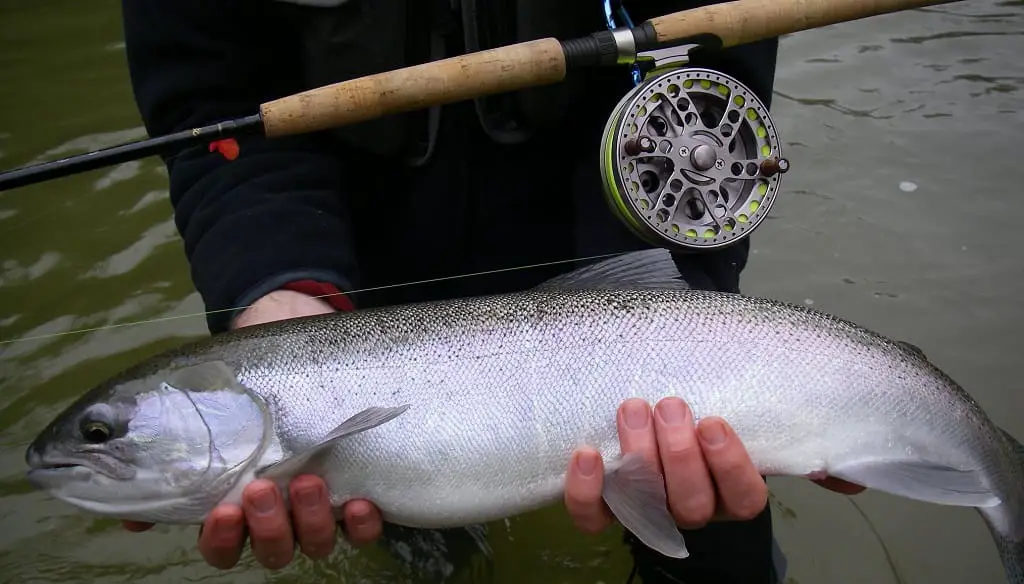
The float fishing leader setup is the bottom section of your line below your float. My leader is made up of multiple sections.
For my float leader setup, you will need a good float that is designed for river fishing, 2 leader lines, 2 swivels, split shots, a good hook, and your bait. I will show you how to put it all together correctly so you are effective in all river conditions.
I will also show you my best two-bait rigs, as well as my deep-water float rig.
I use these float leader setups with great success on West Coast steelhead, salmon, and trout rivers.
We may make a small commission from some of the links on this website, which is at no cost to you. I appreciate your support.
What You Need To Build A Good Float Fishing Leader
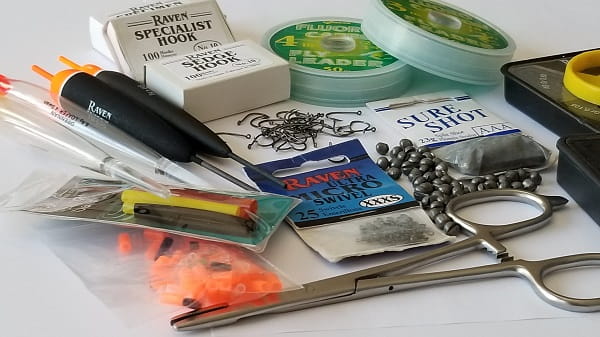
Before you get started, you will need the right components to make the leader effective.
Based on my experience, using the wrong float, the wrong weights, the wrong leader size and type, or the wrong hooks can limit your success.
To make my float leader setup, you will need the following items:
- River Floats – Raven FM floats – Get at FishUSA.com – HERE
- Float Caps – Get at FishUSA.com – HERE
- Leader Line – 6lb, 8lb, and 10lb – Get at FishUSA.com -HERE
- Swivels – Get at FishUSA.com -HERE
- Weights – Split Shots – Get at FishUSA.com
- Hooks – Get at FishUSA.com – HERE
- Bait – See my page Best Baits For Float Fishing
- Forceps or Pliers – For pinching on the split shots.
- Scissors or Nippers – For cutting the leader.
FishUSA.com is one of the few places online that have it all in one place, and they have great prices.
River Fishing Floats and Bobbers
Some anglers will call them bobbers, but when you are a river angler, they are referred to as floats. Floats are a very important part of your system, but not all floats are good for river fishing.
You only need three types of floats for most rivers in North America:
- A solid-bodied float: This is a good general-purpose float.
- A clear float: Best for stealthy presentation.
- A slip float: Best for deeper water over 13 feet.
All floats should have a pointed top that enables you to control your drift, determine your leader angles, and control your speed, all of which will greatly improve your ability to catch fish.
The Raven Tackle floats are likely the most popular float around the Great Lakes region and are growing in popularity out west, and for good reason, they work, they are inexpensive, and they are designed by float anglers.
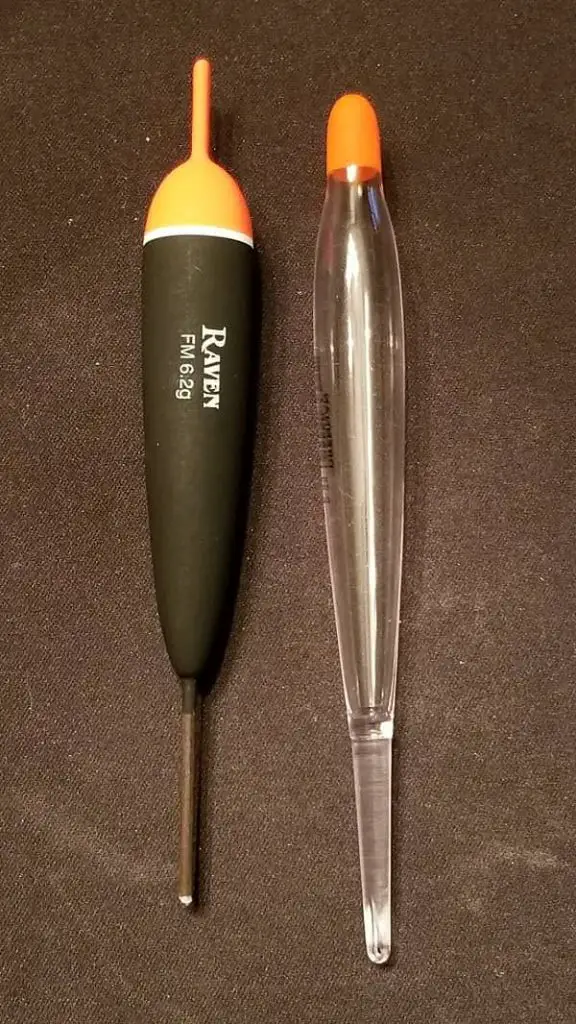
I use the Raven FM floats for most normal small to medium-sized rivers. For the right floats and sizes for different conditions and for the proper setup of the floats check out my page on the 5 Best Centerpin Floats For 2021
For very clear or slow water when the trout, steelhead, or salmon are very cautious, I will use the clear Drennan Loafer floats. These are often my go-to floats for trout in a really clear trout stream.
Leaders: The Best Ones For Float Fishing
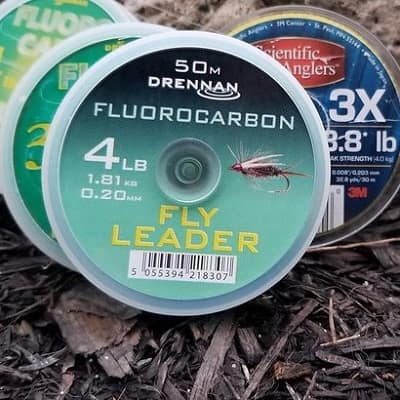
The leader material you buy and use is essential when setting up your leader.
A leader that is too thick will be seen by the fish and you will struggle to get them to bite your bait. A leader that is too thin will mean more fish will bite your bait, which is great, but you will likely break off too many fish.
I also recommend buying and using only high-quality fluorocarbon leaders from reputable brands.
What Size Leader Is Best?
Leader Sizing Chart for Steelhead, Salmon, and Trout
| Fish Type | Fishing Conditions | Leader Size (mm) | Leader Size (inches) |
|---|---|---|---|
| Small Trout | General Use | 0.12mm to 0.177mm | 0.004″ to 0.006″ |
| Steelhead and Large trout | Very clear water conditions | 0.18mm | 0.007″ |
| Steelhead and Large Trout | Clear to green water conditions | 0.20mm | 0.008″ |
| Steelhead / Smaller Salmon | Off-colored, dirty water, fast rivers, or wood-rich rivers | 0.22mm | 0.009″ |
| Steelhead And big Salmon | Really big water, such as Niagara River or West Coast rivers | 0.23mm to 0.26mm | 0.009″ to 0.010″ |
| Salmon | Great Lakes and small rivers | 0.22mm | 0.009″ |
| Salmon | Large rivers | 0.23mm to 0.26mm | 0.009″ to 0.010″ |
On most small to medium-sized rivers around the Great Lakes, my go to leader size is 0.20mm or .008in.
Weights And Swivels
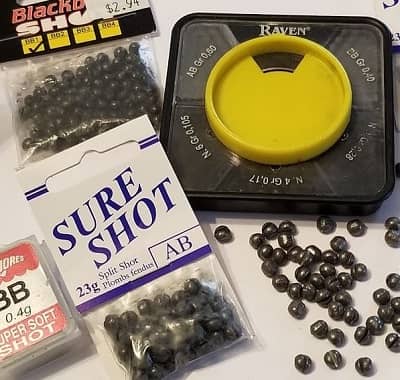
You need weights for your leader setup.
Without them and with the wrong ones or the wrong sizes, you won’t have much success in moving water that is over three feet deep.
The weights I use are called split shots, and the best split shots will be dark in color and not shiny silver.
I use BB and AB size split shots the most. You can get the Sure Shot brand that I use at FishUSA.com.
Some states do not allow the use of lead weights, so I will use the Orvis Non-Toxic Oval Split Shot instead when I fish in those states.
I have an entire page on Weights For Fly And Float Fishing: Everything You Need To Know.
Swivels For Float Fishing
To make my leader setup, you will need two swivels. I use the Raven Micro Swivels when fishing for steelhead and trout. You can get them at FishUSA.com – HERE
If you are not sure how much weight to use for your float, all floats are different but there is a way that works for me, and I discuss this on my page Float and Weights Setup: How Much Weights To Use.
Hooks
I use different hooks and hook sizes. I change sizes based on the size of the fish, the type of bait I use, and the clarity of the water.
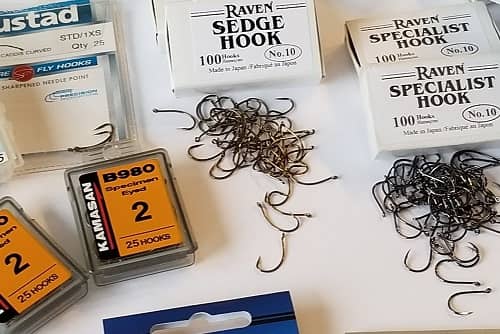
The hooks I use when guiding are:
- Raven Sedge hook: in sizes 4 or 10. Good for stealthy applications
- Raven Wide Gape Specimen Hooks: in sizes 4 or 10. Best all-around hook.
- Gamakatsu Octopus hook: in sizes 4 through 12. Probably the most popular hook for float fishing.
You can see all the hooks that I recommend and use, and my tips on when to use them on my page 4 Best Float Fishing Hooks.
Forceps Or Pliers
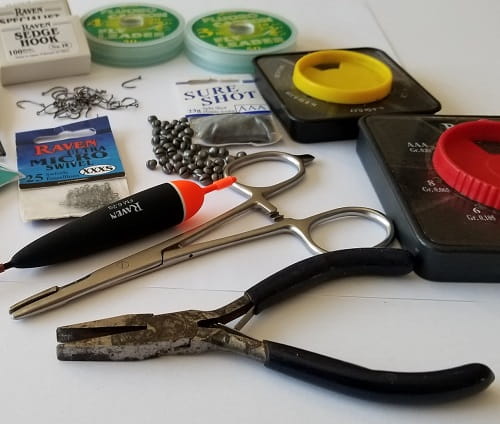
Forceps or plies will be required to pinch on the split shots.
Pinch them on only enough to secure them but not crush them. Crushing them may damage the line or make them go flat, which can cause the line to spin.
Shot Lines and Shot Patterns For Float Fishing Steelhead
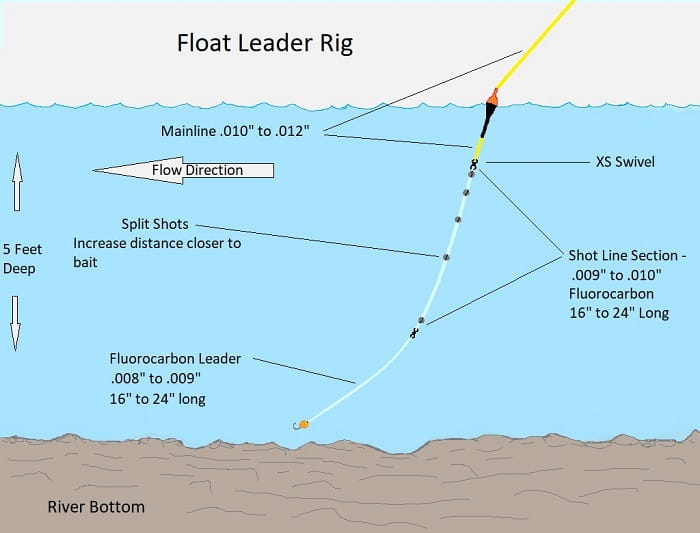
I use something called a shot line for my float fishing leader setup, and recommend it to all my clients for their leaders.
The shot line allows me to use a colored mainline or a clear line. The shot line is heavier than the lower part of the leader where the bait goes.
I usually use a shot line that is one or two sizes heavier than my lower leader.
Because the shot line is heavier, it lasts a long time, and it’s reusable because it rarely breaks.
The mainline on your reel should be heavier than the shot line, and the shot line should be heavier than the lower leader line. You want the shot line to be heavier than the bottom leader because you want the bottom leader to break near the hook and not up the line.
There are two ways to set up your shot lines. My way is to use all the same size split shots and to space them out further apart as they get closer to the bait. You can see this in the picture.
You can see both options in this diagram.
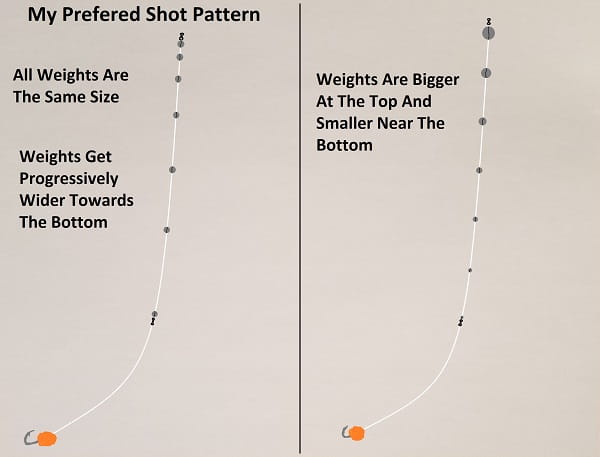
The other option, which you can see on the right in the picture is to use a larger split shot on the top, and then they progressively get smaller and smaller as you get closer to the bait while maintaining the same distance between each split shot.
The thing with both methods is that the results are exactly the same, they both have more weight at the top and less weight at the bottom, but my way is faster to set up, and it only requires one size of split shot, which is cheaper and easier to carry in your fishing vest or pack.
The goal with the heavier weight at the top and the lighter weights at the bottom is to create the leader angle that you see in both of my diagram pictures. With the heavier weight at the top and lighter weight at the bottom, the idea is that the bait will go first so as not to spook the trout with the split shots, heavier leader line, or the float.
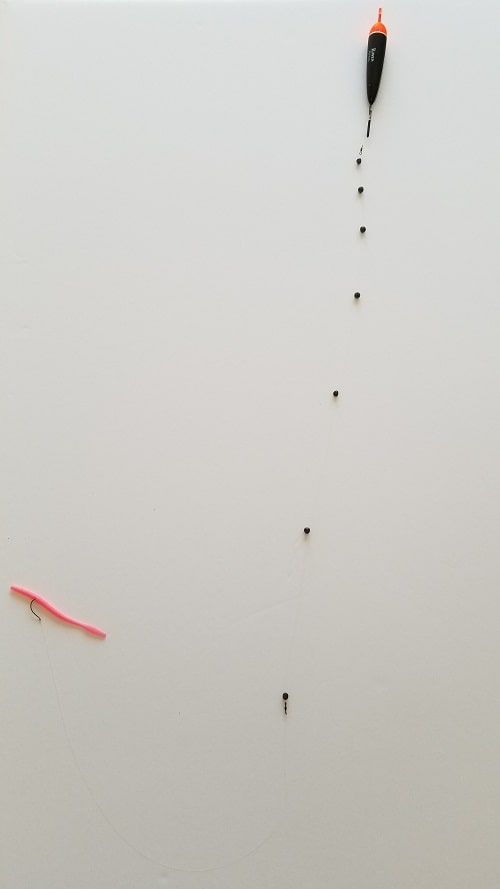
There is much more to this than just the bait going first, and it’s a concept that you should know if you really want to improve your success. I discuss this and the four key fundamentals to catching more fish when float fishing on my page Float Fishing: Tips From A Pro River Guide For More Trout.
FYI, I use 7 AB-size split shots with a 6-gram float.
This is the best general-purpose leader for trout and steelhead and on almost all slow to fast-moving rivers.
I would increase my float size, and my weights, and my hook size on very large West Coast rivers or on big rivers like the Niagara River.
Shot Line Length
The length of the shotline will depend on the average depth or the shallowest depth of water that I will be fishing.
When fishing rivers with spots from 36 inches to 6 feet deep my shot line is twenty inches. A 20-inch shot line combined with a 16″ lower leader will give me a total length of 3 feet and this will allow me to fish as shallow as 3 feet. I can easily slide my float up to fish 4 or 5 or 6 foot deep pools.
If I get into 6 to 8 foot pools I can still slide the float up even further.
Why I Always Use A Shot Line?
A reader just asked about what happens in shallower water and he asked if he just slides the float down and over the top swivel. My answer and the three reasons that I always use a shot line is this.
The reason for the swivel and the separate shot line is so that I can run a piece of fluorocarbon leader where my split shots go. There are three reasons for doing this.
1. The fluorocarbon is more abrasion resistant than your mainline (which is usually mono), so it’s less likely to break should it hit rocks or logs that are below the surface.
2. The fluorocarbon shot line allows me to go lighter than the mainline, so not only is the fluorocarbon more invisible underwater than the mainline, but it’s also thinner, and that makes it even more invisible to the fish.
I know for a fact that in some situations, guys that run their mainline all the way down to the bottom swivel will be spooking some fish that see the line.
3. The fluorocarbon is also a clear line, which allows me to use a high-viz line as my mainline, (which I always do). The high-viz line has a lot of advantages over a clear line, or a green line, especially for someone who is learning or for a guide like me that teaches most of the time.
You should never run your high-viz line down to the lower swivel. This often results in fewer fish hooked.
Getting your angles right is critical to catching more fish when float fishing. If you aren’t sure about getting the right angles, you should check out my page Centerpin Fishing: An Expert Centerpin Guide Explains It.
Fishing Deep Water With My Leader Setup
Someone asked a question about what to do if you fish deep water. For me, deep water means about 8 to 15 feet deep, and I have two options for you.
Deepwater is a bit tricky because it usually requires more weight to get the bait all the way down to the bottom. If you add more weight, you will also need to up-size your float. This is why you will see guys using 12 to 20-gram slip floats on big rivers like the Niagara River or out on the big West Coast steelhead rivers.
You will want to use only as much weight as you need to get the bait down. You then only use a float that can handle all that weight. If you need more weight, you upsize your float, if you need less weight, you downsize your float.
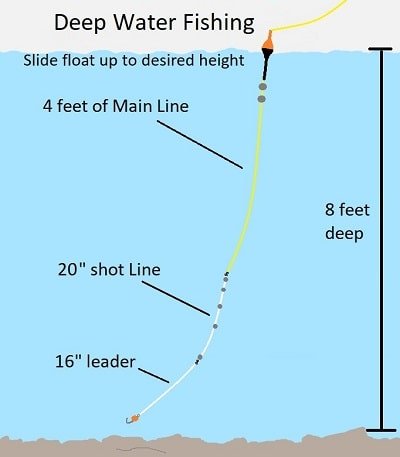
As you can see in the diagram, if I am fishing in a river where most spots are 3 to 6 feet deep, but 1 or 2 spots are 7 to 15 feet deep, I still use the same leader, but I just simply slide my float up the line to the desired depth and leave my shot line and everything else exactly as it is.
It’s almost like the bulk shotting method that I will talk about below since all your weight is near the bottom and near the fish.
If I fish a lot in the deeper water, I use the deep water leader setup below.
I will also sometimes add a second leader with a second bait of about 12 to 20 inches tied off the hook bend of the top hook to make the whole leader longer and to get the shots and shot line higher up and away from the fish.
Adding the second leader and bait makes the entire leader closer to 6 feet deep which is better in the deeper water of 8 to 12 feet deep, and so there is less mainline in the water. I will add a split shot between the two baits to ensure the bottom bait is getting deep enough, or I’ll use a heavy bait like a glass bead to get it all down.
If I move back into shallower water again, I can just remove the second bait and leader so I have a short leader again.
2 Deep Leader Setups
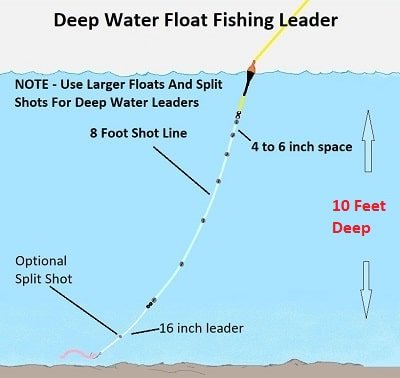
If I’m fishing a bigger river where all the spots are 10 feet or more, my setup is a bit different.
I will make a shot-line of about 6 feet long and use much larger split shots, and then space them out in the same basic pattern as I would with my regular shot line.
The main difference is that on my normal shallow-water shot-line the space between the top two split shots might be only an inch apart because I need to get 5 to 7 splits on a 16 to 20″ piece of leader, therefore, they all need to be closer.
But on my longer leader setup, I will use a 6-foot to 8-foot long shot line and the space between the top two split shots might start around 6 inches because now I have to fill up 6 to 8 feet of leader, and not just 20 inches of leader.
With the deep water leader, you will need to upsize the split shots to be sure the leader works properly and that the bait gets down fast enough.
I use lead shots around the size of a pea, AA or AAA sizes, or ones that are double the size of my normal AB-sized split shots. If you don’t have larger shots, just double up your AB or BB shots.
Your float size also needs to increase accordingly. A 12 to 16-gram float is usually required. Slip floats are often the best when fishing water is deeper than your float rod is long. This will help you cast and land fish easier.
Fast Water Leader
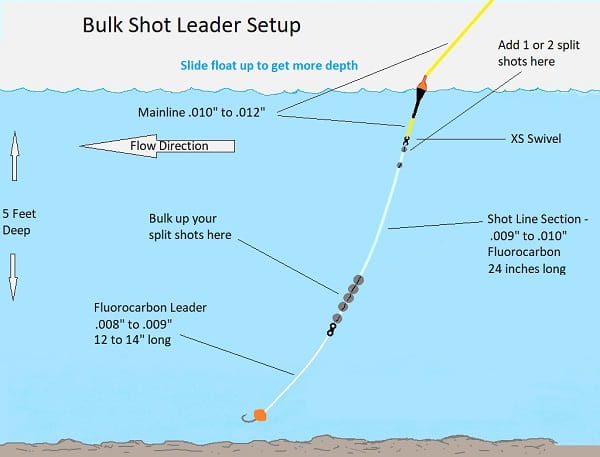
This fast and deep leader setup, which is known as a bulk shot leader or bulk shotting, is one that I might use when I need to get my bait down to the fish very fast.
With this rig, all 5 out of seven split shots are placed 12 to 14 inches from the bait, which will get your bait down really fast.
Keep the same length of shot line section for all depths, and just slide your float up or down to get the desired depth.
I also keep the bait 8 to 14 inches from the lowest split shots so that it gets down and stays down. In fast water, the fish won’t notice the split shots, so you can keep them closer than you normally would.
I only use the bulk shot setup if the fish are holding at the bottom of deep drop-off ledges like in the picture below.
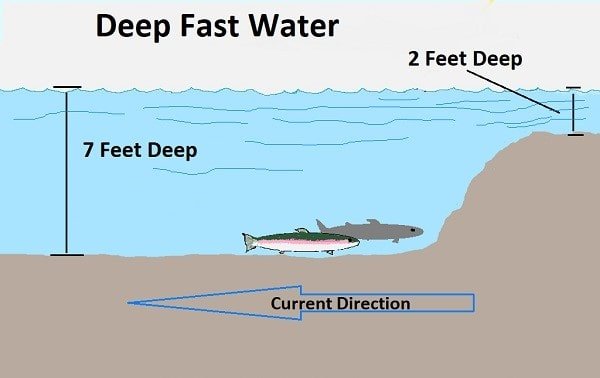
I would cast a couple of feet before the drop, and the weights would pull the bait down the slope of the drop and into the strike zone.
This would be the only time I would use this type of leader, all other times my standard float leader setup is better.
Is Split Shot On The Bottom Leader OK?
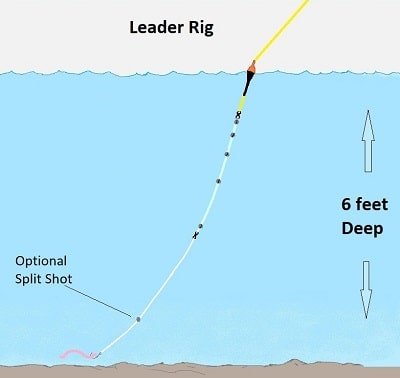
Someone recently asked if it was okay to add a split shot to the bottom section of the leader as seen in this diagram, and the answer is yes, but only do it if you need to.
The reason I don’t do this very often is that the split shot between the bottom swivel and the bait can easily slide down and hit the bait.
As long as you are observant and keep checking to make sure that split shot doesn’t slide down to the bait it will be fine, and it could even work better than not having it there, especially when fishing more buoyant baits.
Guide Tip: I have been known to use a split shot between the bottom swivel and the bait when I use more buoyant baits like a Berkley Trout Worm, but you could do it with any bait if you feel you are not getting down to the fish.
2 Bait Leader Setup – 2 Ways
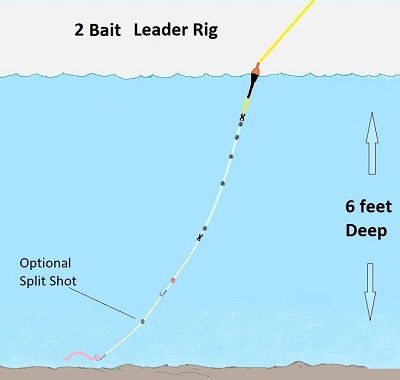
When I use a double bait rig, the second bait is often far from the closest split shot, and that can mean that the bottom bait won’t be able to get down to the fish or won’t stay down.
This is more true on lightweight or buoyant baits like plastic worms.
Therefore, when I fish two baits, I will either use a heavy bait like a glass bead on the bottom, or I will sometimes add a split shot between the two baits to be sure that both baits are getting down to the fish and the bottom. Be sure two baits and two hooks are legal in your area first.
You can see how to fish beads and which beads I prefer on my page Fishing With Beads: 5 Guide Tips For More Fish
Easy 2-Bait Rig For Steelhead And Trout
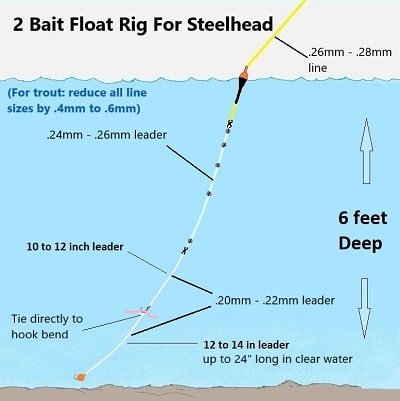
For this 2-bait float fishing rig, I tie the second line off the bend of the hook.
This is a fast and easy way to rig two baits on a leader or extend your single bait leader length.
If it gets too shallow for both baits, I just cut the one off and only use one bait again.
This allows me to fish shallow and deep easily, and it allows me to experiment with baits and see if two baits are more effective than one bait.
When the water is not clear, I will keep the two baits 12 to 14 inches apart, but when the water is very clear, I will often increase the distance between the baits up to 24 inches because the fish will be able to see the bait from a distance.
Alternative 2-Bait Float Leader Setup
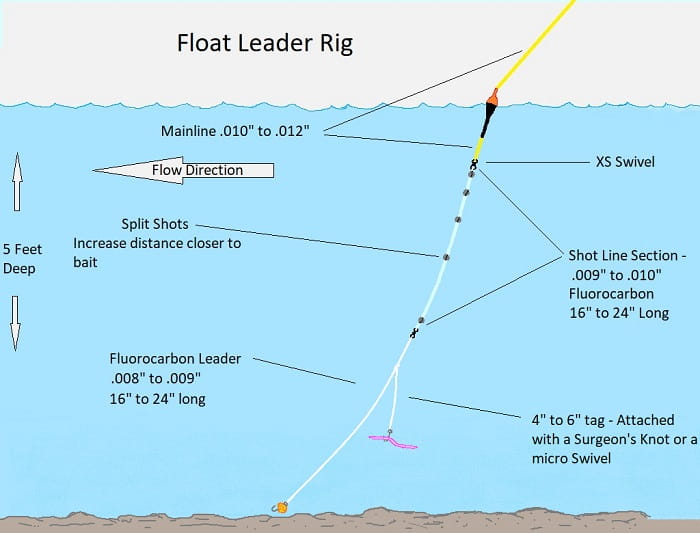
Another 2-bait setup that I use when guiding and fishing is this 2-bait tag rig.
Instead of tying the second leader off the bend of the hook, I add a 4 to 6-inch tagline with a hook on it.
This allows better movement of the bait, and better hookups because the fish can inhale it better.
I will either tie the tag off the micro swivel or off of a triple surgeon’s knot; I just leave one long tag and cut the other tag off.
Leader For Shallow Water
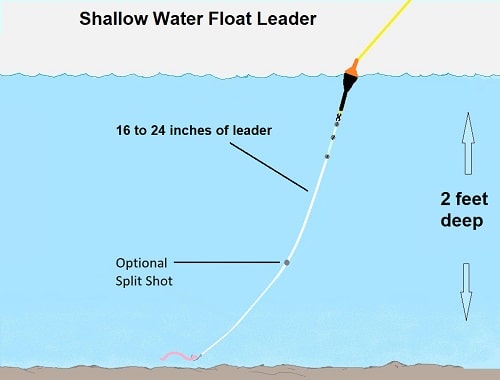
The best shallow water leader set up when fishing in water that is three feet deep or less is this one.
To be honest, I don’t float fish in 2 feet of water or less unless the water is off-colored because the fish are likely to see your float or weights and then be spooked.
Just because you have an excellent leader setup doesn’t mean you will catch fish. You MUST know how to use it effectively. I discuss the four key fundamentals to becoming a successful float angler on my page Float Fishing: Tips From A Pro River Guide For More Trout
Tight Lines
Graham

Hey graham i just starting to get into steelheading and got my first centerpin. When i was reading this i found that your set up is much different from others i just have a question, why is there a swivel below the float when in some situations the pool is deeper so you’d have too move your float and split shots but the swivel is stopping that?
Hi Joshua, good question. The reason for the swivel and the separate shot line is so that I can run a piece of fluorocarbon leader where my split shots go. There are 3 reasons for doing this.
#1. The fluorocarbon is more abrasion resistant than your mainline (which is usually mono) so it’s less likely to break should it hit rocks or logs that are below the surface. I tell my clients that if you cut mono 50% of the way through the line you lose about 80 or 90 percent of its strength, which means the 10-pound line is now 1 or 2 pounds, but if you cut fluorocarbon 50% of the way through you will retain about 50% of its strength. Now, that’s just a guess, but based on my findings nicked mono breaks much easier than nicked fluorocarbon.
#2. The fluorocarbon shot line allows me to go lighter than the mainline so not only is the fluorocarbon more invisible underwater than the mainline, but it’s also thinner and that makes it even more invisible to the fish. I know for a fact that in some situations, guys that run their mainline all the way down to the bottom swivel will be spooking some fish that see the line.
#3. The fluorocarbon is also clear which allows me to use a high viz line as my mainline, (which I always do). The high viz line has a lot of advantages over a clear line,or a green line, especially for someone who is learning or for a guide like me that teaches most of the time.
The total length of my leader from that swivel to the bait is usually 3 feet. That allows me to fish a 2.5-foot to 3-foot spot providing I get the right angle that I talk about.
It’s rare that I will float fish a spot that is less than 2.5 feet deep and if I do, I simply pull the float caps off my float and slide them over the micro-swivel and then slide some weights down and then put my float back on below the swivel at the desired depth.
Should I find fish in pocket water or in really shallow water I will usually take the entire leader and float off and switch to bottom bouncing which is far more effective in that type of water. Thanks for your question. I will likely add this to the post for others.. Good luck this spring.
Hello,
I was reading this article and you state that you use 7 AB shot for a 6gr float(7×.60 is 4.2grs.)
I’ve heard people say you need to match the shot weight to float weight (7gr float/7gr shot etc.) Is that true? Or is it better to stay under the float weight?
Thanks for all the knowledge, love your content.
Hey Corey,
Good question, I weight my line so that the line on the float is at or just below the water level, and I tend to go slightly lighter because on some baits like plastic worms that float I’ll often add an extra weight 12 inches up from the worm to ensure it stays down. I also prefer to weight just enough in-case I switch to glass beads or a weighted fly.
My best advice is to figure out the weights that work best for your type of float and for the baits that you use. Hope that makes sense.
Good Luck
Graham
I have a question about the bottom leader line from the bottom swivel to the bait.
In your opinion is it ok to put 1 split shot on this line to ensure the bait stays down?
Hi Mike, Good question and I answered it in the post in more detail with a couple of diagrams for you. The simple answer is yes, it’s definitely ok to do and it can also work better in some cases, providing that you watch it closely and that don’t let it slide down to the bait, see my Guide Tip for that.
Hi Graham really enjoy reading your material.
Thanks Phil, I’m hoping to keep growing the website and making it better.
Hey Graham –
When casting up river into the current, does “slowing” the float still apply considering there’s no way to really mend the line or control the rate of drift until the float is somewhat downstream (or left) of the angler’s position? In other words, when using a float, you’re not really “fishing” until that float begins to go down river with the flow of the current. Once down river, it’s possible to ensure the float tilts in the opposite directly of the current flow. Just wanted clarification. Thanks for all the info you have posted thus far.
– Chris
Hi Chris,
You are correct, I almost never let my clients cast upriver because you can not control float and leader angles and speed. I always try to be upriver of where my target zone is and always fish from the top of the zone down and try to cover the water systematically. See how I cover the water HERE.
Check out my page Controlling Your Speed For More Fish When Float Fishing
Good luck
What is your recommend exact lenght of the shotline and leader?
Hi JC, I added a section on shot line length.
When fishing rivers with spots from 36 inches to 6 feet deep my shot line is twenty inches. A 20-inch shot line combined with a 16″ lower leader will give me a total length of 3 feet and this will allow me to fish as shallow as 3 feet. I can easily slide my float up to fish 4 or 5 or 6 foot deep pools.
Hey Graham, Great content! This has been incredibly helpful!
I fish Lake Erie tribs and the vast majority of anglers I see are using a 2-bait rig almost always despite depth. If you are fishing a 3 or 4 foot spot, will you ever use a 2-bait rig or is that only for deeper water?
Thanks!
Hi Mike,
I use 2 bait rigs all the time. 3 feet is a bit shallow for a 2 bait rig, but 4 feet plus should be ok. If you fish a lot of shallow water 3 to 5 feet, just make your shot line shorter and the distance from your bottom swivel to your bottom bait can stay around 14 to 20 inches
Hey Graham, What float set-up would you suggest when fishing stocked ponds where the rainbows are normally smaller. Plan on using a 7 foot light action rod and wondering what size of line i should be using for the main line, shot and leader lines. Also do you ever use braid for just the main line on either of your setups?
Thanks so much
John
Hey John,
I would use my standard leader or a leader with a slip float. I’ll be discussing slip floats later on. The line sizes depend on how picky they are but in general I would drop down 2 sizes on all lines. A 2 to 4-pound leader should be good enough for smaller stocked trout. The mainline off your reel is irrelevant as long as your leader is long enough that the fish won’t see the mainline. However, 6 pound mainline should be good, and a braided line will also be good as long as the fish don’t see it.
Good luck.
Graham
Hi Graham,
Would you also use a shot line for salmon fishing (Vancouver island)? If so, would it be the same as explained above?
Also, what’s your take on the following set up. Fixed float on mainline, weight, bead, snap swivel and a 22 inches leader length max?
Thx!
Hi Oliver,
The last time I fished Vancouver Island weights on the line were not permitted, however, maybe it was just the area or river I was fishing.
I don’t stray from the leaders I show on the page since they are proven to be the most effective. I would definitely not put a snap swivel on the leader with a float.
Graham
Thank you very much for your response Graham! All the best!
Hey Graham, great article! I am from BC and many rivers I fish have deep pools up to 20ft+. The norm here is using a slip float with a small rubber bobber stop to keep the float at the right depth. I never seen people use split shot, but your article is fantastic and I love to try. Here everyone uses a 25 to 30g float with only one single 20g egg sinker on mainline; no shot line, then 18” leader then bait/hook.
Do you have any articles on float fishing with a slip bobber? Do you use still use the shot line for that or even for 25-30g floats?
Also wouldn’t it be easier just to use one giant egg sinker rather then many split-shots so it’s basically acting like a bulk shot every single time? Just curious as to why no one used split shots in BC even for 5-10ft pools, every uses just a single pencil lead or heavy egg sinker.
Cheers
Hey Ryan,
Great Questions,
There is definitely a difference in style between the great lakes float setup and method and the BC Style.
For me, when fishing spots deeper than my rod is long, I’ll use a slip float, and often I’ll continue using the same split shot method unless all the spots are deep. With slip floats or fixed floats I will upsize my weights or the quantity of weights based on the velocity and depth of the current. For spots 13 feet or less I always prefer a fixed float with split shots as seen in the article.
If the water is fast on the surface and less than 10 feet deep, my experience has proven that using split shots (heavy at the top and lighter at the bottom) and then controlling the angle and speed of the float is superior to bulk shoting with an egg sinker, pencil lead or multiple split shots bulked up. Unless there’s a fast drop and I need to get my weight down super fast, then the bulk shot rig can be better.
In slow surface water spots, especially if its deep, bulk shotting works very well, and maybe even better that the split shot setup, so stick with it.
The reason I prefer and all the guides around the great lakes use split shots is because the majority of spots we fish are 4 to 10 feet deep and medium speed or less.
In my opinion, part of the reason why BC anglers all use the same method, and why Great Lake Steelheaders all use a different method is a “monkey see, monkey do” mentality. Meaning, once something catches on and everyone uses it, why change what is already working. Most guys don’t think outside the box so they get stuck in their ways.
The last time I fished steelhead in BC the guide was blown away by how many steelhead I was hooking with my rig and asked me to show him how I was able to hook so many in such a short time, this proves that splits shots and alternative methods can and do work in both BC and great lakes area.
Best of luck,
Graham
Also 25 to 30 gram floats is overkill in my opinion unless your fishing something like the main stem of the Skeena. Again, old school ways.
Question? When you fish a specific gram float, does your shot line as a whole equal the grams or ounces on the float?
Hey Michael,
To be honest I don’t set up my shot lines based on the float grams as you mentions for three reasons. #1. I’m too lazy to measure out weights (I just know how many weights work and how many I need) #2, Sometimes I use heavy baits like glass beads or weighted flies and if you overweight your float with weights, the bait might make the float to deep. #3. Under certain situations I will add another weight or two on the lower leader to ensure my bait gets down faster and stays down.
I also pre-tie my shot lines and since I change floats based on conditions, I make my shot lines suitable for 4g and 6g floats, and if I need to use an 8 gram float or if my shot line is too light for a float, I’ll usually add a split shot or two above my shot line (just above the top swivel. That way if I need to drop to a small flaot I can just cut off those split shots and re-tie the one knot (mainline to swivel).
I hope that makes sense.
Graham
Hello Graham,
Hope you are doing well!
When fishing for salmon (Chinook, Coho), high vis line, fast water, 6 to 8 feet deep, 20 to 30gr float. I was thinking to use a slip float set up (hoping that it will be easier to cast…still learning the craft), with an inline weight (10gr or so) right under the float (in order to quickly anchor the float ) and then a tapered shot line (24″) then 12 to 16″ inch leader with a 14mm bead.
Please let me know your thought whenever you have have time to spare! Thx!
Olivier
Hi Oliver,
Anytime one of my clients wants to try other setups from the ones I show them is because they are not getting the results they think they should be getting. A lack of fish is rarely from a good setup, it’s usually from the way they fish the setup! I’ve watched thousands of anglers poorly fish great setups and still catch no fish.
1. You do not want to anchor your float with one big weight!! You want to be able to use your float to determine leader angles and bait speed. If your float is heavily anchored and stands straight up all the time you can not determine speed and angles well. Controlling your speed is critical for catching more fish. Use a good float (not one of those flat top floats or round top floats) and be sure it’s properly weighted (less is better). – I’d use an 8 to 10 gram float in 6 to 8 feet deep fast water with no issues getting the bait deep enough.
2. I have never had the need to use a 20 to 30 gram float in water under 10 feet deep. If the water is so exceptionally fast that you need that much weight and that big of a float, it’s probably not great water for catching salmon anyways. Most angler use way to much weight!
3. Slip floats are ok to use at anytime as long as you can secure it so the “set-depth” (float stop) does not move on it’s own with hook sets or fighting fish. FYI, I NEVER use slip floats until the depth I need to fish is 3 feet longer than my rod. Based on my experience, slip floats tend to slip on their own so the leader gradually gets shorter, and most anglers do not pay close enough attention to this and end up fishing many drifts in unproductive water that is way over the fishes heads. – I’d stick to a fixed float.
4. Do not listen to other anglers telling you what setups are best. There is a saying… 10% percent of anglers catch 90% of the fish. Meaning 90% of anglers are not good at catching fish, so don’t listen to them.
5. If you do not like my proven setup, find the best salmon guide in your area and use his setup only. If he is the best, his setup will be proven to be effective. FYI, I’ve guided plenty of guides that sucked, so find the best guide, not some random dude who thinks he’s a guide. Find the veteran guide who teaches guides, that’s the guy you want.
And use more that just beads and more that just one size of bead. Unless the water is mud, I would not go as big as 14mm. There are issues with beads and hooksets.. see my articles on bead fishing.
My advice is to use my leader setup with only as much weight as you need to get your bait down, and then get very good at presenting your bait, controlling your speed and your angles. For more, see https://troutandsteelhead.net/float-fishing-for-salmon/
Good Luck.
Graham
Thanks so much Graham for taking the time to reply to my question. Much appreciated! I’ll definitely follow your advice 🙂 Take care !
Olivier
Good Day!
What type of shot line do you use (brand)? I worry about the line fraying when shots are being adjusted. I have used a copolymer for shot line and mainline (Gamma). The breaking strength is what appealed to me but it sounds like you wouldn’t recommend them.
Thanks for the you help!
Jeff
Hey Jeff,
I use Drennan and Seaguar fluorocarbon and never seen it fray from shots, and very rarely from rocks or wood. The thing with flouro is that even if it frays it still stays strong.. Im not a fan of copolymer for the mainline, it sinks more.
Good luck.